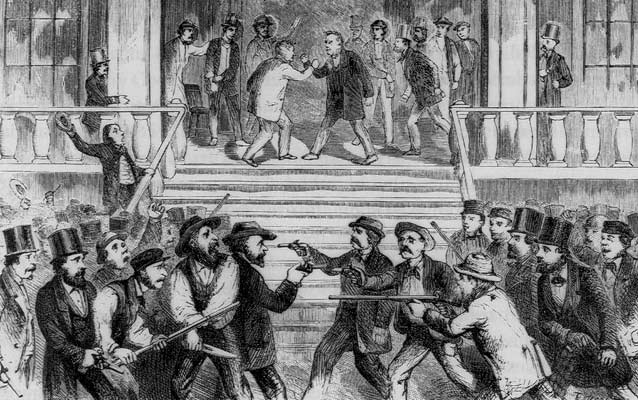Students shared their poems in two voices.
Students wrote a self-evaluation of the poem that completes the statement: My poem ______ the criteria for the assignment. This self-evaluation gives specific information for each bullet in the rubric. Poem and evaluation were turned in.
Students then began pre-writing or drafting the culminating assessment for this unit (assignment posted below). A rough draft is due next class, and the final draft is due on the 17/18th of October depending on which day a student has class.
Living in the USA: Historiography Unit
Culminating Assessment
You have a choice of two topics on
which to write an essay. Regardless of which topic you write on, your
essay will include:
*
awareness of bias or personal and ideological perspective in the writing of
history
*
include supporting evidence from the materials provided in class (or from your
own outside research)
Option 1:
Write a reflection / personal response
essay to your previous history teachers or to your younger self as a student of
history. In your essay, show your understanding of the decisions that
were made in the version of history you were taught, and what you think about
that version now after having completed this unit. Show your awareness of
how personal bias (of time, politics, gender) has influenced your learning of
history.
Option 2:
Write an essay on your previous
experiences studying history. In your essay, show how your learning
history is an example of five degrees of separation from the event(s) being
taught. Show your awareness of how the decisions in writing the history
of this event demonstrate personal bias (of time, politics, gender, social
class) influenced this version of history.
Regardless of which option you choose,
you may want to include responses to the following questions:
(1) Whose voices and experiences were
part of your learning history?
(2) Whose stories were told?
(3) Whose were left out?
(4) How were events portrayed?
(5) Who were the “winners” and who were
the “losers”?
Your essay will
include at least three pieces of textual evidence from any of the
materials we’ve read in class. Final drafts will be typed, double-spaced
in a Times New Roman or Palatino type-face in a 12 point size. It will
also include an introduction, a thesis statement and a conclusion.
|
Exceeds
|
Meets
|
Does
Not Meet
|
- Strong
introduction with engaging hook that captures the reader’s attention
- Exceedingly clear thesis statement
|
- Introduction includes
thesis statement
- Thesis statement is clear and demonstrable
|
- Missing
introduction (or uses definition in introduction)
- Thesis statement is unclear or not demonstrable
|
- Essay is
compelling to read
- Transitions
assist organization of essay
|
- Organization
of essay is easy to follow
- Essay includes
transitions
|
- Organization
is clunky or ideas are difficult to follow
- Transitions are missing, awkward or inappropriate to topic of
paragraph
|
- Demonstrates a
sophisticated understanding of how historiography reflects bias or
perspective in writing history through social class, gender, race, etc.
- Includes 4 or
more pieces of textual evidence
- Analysis of evidence strongly supports claims made in thesis
|
- Appropriately
uses the term “historiography” in the essay
- Includes 3
pieces of textual evidence
- Textual
evidence is related to thesis
|
- Little or no
understanding of the concept of historiography
- 2 or fewer
pieces of textual evidence
- Textual evidence doesn’t support claims or thesis.
|
- Conclusion is
clear and strongly demonstrates fluency with topic
|
|
- Missing or unclear conclusion that does not demonstrate an
understanding of the topic
|
- Few or no
errors in conventions of standard written English
|
- Some errors in
conventions of standard written English
|
- Several errors
in conventions of standard written English
|




